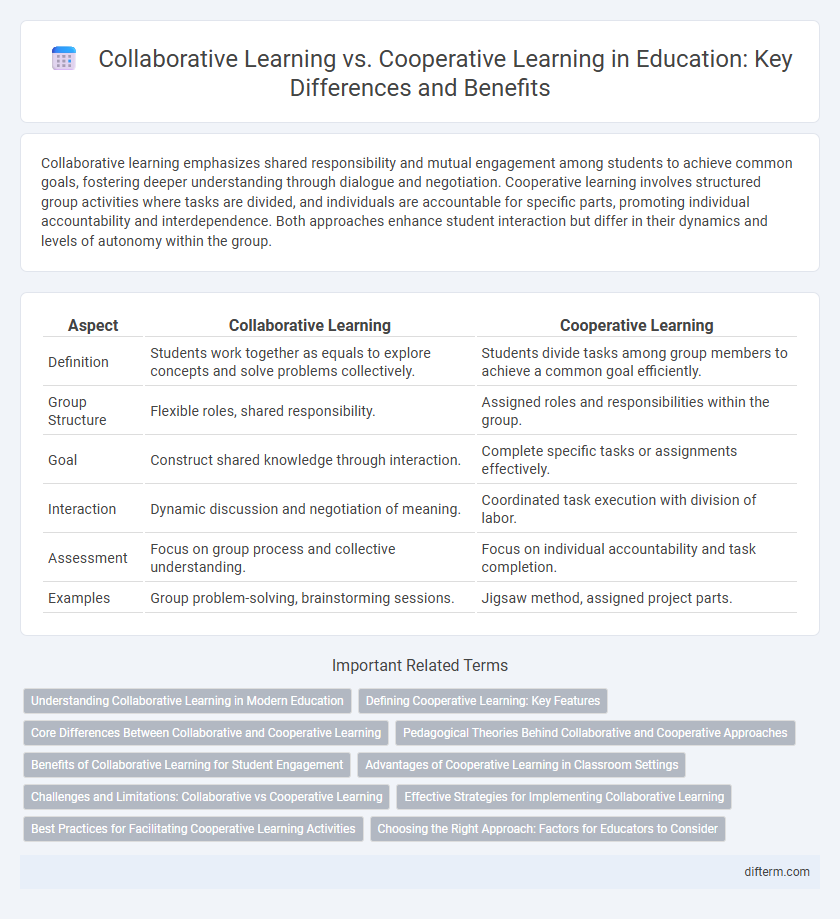Collaborative learning emphasizes shared responsibility and mutual engagement among students to achieve common goals, fostering deeper understanding through dialogue and negotiation. Cooperative learning involves structured group activities where tasks are divided, and individuals are accountable for specific parts, promoting individual accountability and interdependence. Both approaches enhance student interaction but differ in their dynamics and levels of autonomy within the group.
Table of Comparison
| Aspect | Collaborative Learning | Cooperative Learning |
|---|---|---|
| Definition | Students work together as equals to explore concepts and solve problems collectively. | Students divide tasks among group members to achieve a common goal efficiently. |
| Group Structure | Flexible roles, shared responsibility. | Assigned roles and responsibilities within the group. |
| Goal | Construct shared knowledge through interaction. | Complete specific tasks or assignments effectively. |
| Interaction | Dynamic discussion and negotiation of meaning. | Coordinated task execution with division of labor. |
| Assessment | Focus on group process and collective understanding. | Focus on individual accountability and task completion. |
| Examples | Group problem-solving, brainstorming sessions. | Jigsaw method, assigned project parts. |
Understanding Collaborative Learning in Modern Education
Collaborative learning in modern education fosters critical thinking and problem-solving through interactive group activities that emphasize shared goals and individual accountability. Unlike cooperative learning, which often assigns specific roles to manage tasks, collaborative learning encourages organic student interaction and knowledge construction. This approach enhances communication skills and deeper comprehension by promoting mutual support and diverse perspectives in classroom settings.
Defining Cooperative Learning: Key Features
Cooperative learning is an educational approach where students work together in small groups to achieve shared academic goals while developing interpersonal skills, emphasizing positive interdependence and individual accountability. Key features include structured group roles, face-to-face interaction, and group processing to reflect on performance and collaboration. This method fosters deeper understanding and retention by combining social and cognitive development within a supportive learning environment.
Core Differences Between Collaborative and Cooperative Learning
Collaborative learning emphasizes group members working collectively to achieve shared understanding, fostering critical thinking and knowledge construction through open dialogue. Cooperative learning involves structured roles and predefined tasks, with individual accountability to complete portions contributing to the group's overall success. Core differences lie in the level of interdependence, with collaborative learning promoting equal participation and fluid interaction, whereas cooperative learning features assigned responsibilities and step-by-step coordination.
Pedagogical Theories Behind Collaborative and Cooperative Approaches
Collaborative learning and cooperative learning are grounded in distinct pedagogical theories that emphasize social interaction and shared responsibility. Collaborative learning is influenced by constructivist theories, where knowledge construction is a collective process involving negotiation, dialogue, and critical thinking among peers. Cooperative learning draws from behaviorist and social interdependence theories, focusing on structured group roles, positive interdependence, and individual accountability to achieve shared academic goals.
Benefits of Collaborative Learning for Student Engagement
Collaborative learning fosters deeper student engagement by encouraging active participation, critical thinking, and communication skills through group problem-solving and shared goals. It promotes a sense of community and accountability, which enhances motivation and retention of knowledge. Research shows that students in collaborative learning environments demonstrate higher academic achievement and greater social interaction compared to traditional cooperative learning methods.
Advantages of Cooperative Learning in Classroom Settings
Cooperative learning enhances student engagement by promoting shared goals and structured group roles, which lead to increased accountability and improved social skills. This method encourages positive interdependence, resulting in higher academic achievement and better retention of information. Teachers benefit from more organized classroom management and the ability to assess individual contributions effectively.
Challenges and Limitations: Collaborative vs Cooperative Learning
Collaborative learning often faces challenges such as coordinating diverse perspectives and managing uneven participation, which can hinder group cohesion and individual accountability. Cooperative learning may encounter limitations related to rigid role assignments and predetermined group structures that restrict flexibility and creativity. Both approaches require careful facilitation to address potential conflicts and ensure effective communication among learners.
Effective Strategies for Implementing Collaborative Learning
Effective strategies for implementing collaborative learning include designing tasks that require interdependence among students, fostering positive intergroup relationships, and promoting individual accountability to enhance group productivity. Utilizing diverse group roles and structured dialogues encourages active participation and critical thinking within the learning community. Integrating technology tools like discussion forums and collaborative documents supports seamless communication and resource sharing, optimizing the collaborative learning experience.
Best Practices for Facilitating Cooperative Learning Activities
Facilitating cooperative learning activities requires clearly defined roles to ensure each student actively contributes and develops accountability within the group. Best practices include structuring tasks that promote interdependence, such as jigsaw or think-pair-share techniques, which foster meaningful peer interaction and collective problem-solving. Providing timely feedback and scaffolding helps maintain group focus and supports diverse learners, enhancing overall engagement and achievement.
Choosing the Right Approach: Factors for Educators to Consider
Educators should consider student autonomy, group dynamics, and learning objectives when choosing between collaborative and cooperative learning. Collaborative learning emphasizes shared responsibility and open dialogue, ideal for developing critical thinking and problem-solving skills. Cooperative learning suits structured tasks with assigned roles, promoting accountability and streamlined progress in achieving specific educational outcomes.
collaborative learning vs cooperative learning Infographic

 difterm.com
difterm.com